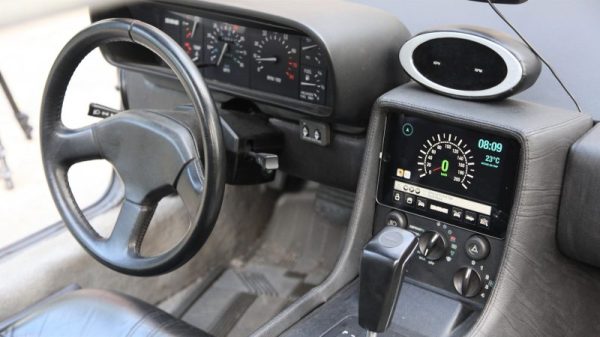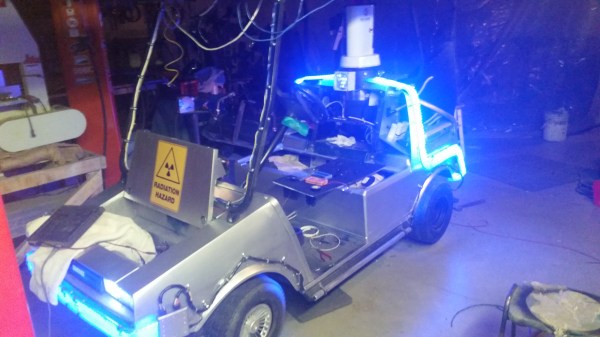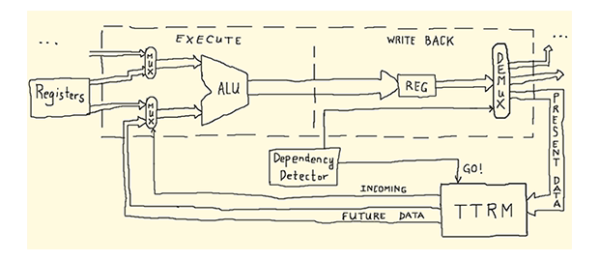A couple of weeks back we featured a story (third item) about a chunk of space jetsam that tried to peacefully return to Earth, only to find a Florida family’s roof rudely in the way. The 700-gram cylinder of Inconel was all that was left of a 2,360-kg battery pack that was tossed overboard from the ISS back in 2021, the rest presumably turning into air pollution just as NASA had planned. But the surviving bit was a “Golden BB” that managed to slam through the roof and do a fair amount of damage. At the time it happened, the Otero family was just looking for NASA to cover the cost of repairs, but now they’re looking for a little more consideration. A lawsuit filed by their attorney seeks $80,000 to cover the cost of repairs as well as compensation for the “stress and impact” of the event. This also seems to be about setting a precedent, since the Space Liability Convention, an agreement to which the USA is party, would require the space agency to cover damages if the debris had done damage in another country. The Oteros think the SLC should apply to US properties as well, and while we can see their point, we’d advise them not to hold their breath. We suppose something like this had to happen eventually, and somehow we’re not surprised to see “Florida Man” in the headlines.
Flux Capacitor7 Articles
IPad, Not Flux Capacitor, Brings DeLorean Back To The Future
Add a flux capacitor and a Mr. Fusion to a DeLorean and it becomes a time machine. But without those, a DeLorean is just a car. A 35-year old car at that, and thus lacking even the most basic modern amenities. No GPS, no Bluetooth — not even remote locks for the gullwing doors!
To fix that, [TheKingofDub] decided to deck his DeLorean out with an iPad dash computer that upgrades the cockpit experience, and we have to say we’re impressed by the results. Luckily, the space occupied by the original stereo and dash vents in the center console is the perfect size for an iPad mini, even with the Lightning cable and audio extension cable attached. A Bluetooth relay module is used to interface to the doors, windows, trunk, garage door remote, and outdoor temperature sensor. A WiFi backup camera frames the rear license plate. Custom software ties everything together with OEM-looking icons and a big GPS speedometer. The build looks great, adds functionality, and should make road trips a little easier.
When [TheKingofDub] finally gets sick of people complaining about where the BTTF guts are, maybe he can add a flux capacitor and time circuits.
[via r/electronics]
Quick Marty! We Have To Go Back, With The Golf Cart!
Talk about an awesome project. [Lucas Evanochko] was commissioned to build this totally rad Delorean style golf Cart for Red Deer College’s 30th annual Golf Tournament.
According to him, it’s been about 600 hours in the making – and they only started building it in July. This past week was its big unveiling, and it has had an overwhelmingly positive response so far!
They started with one of the club’s golf carts and modified it heavily, relying on the automotive expertise of [David Keykants] and [John Perrin] to turn it into the aw-worthy time machine it is today. It has a 7” tablet built right into the dash to play music and use the Fluxy88 Time Circuits app. A big array of arcade buttons hooked up to an Adafruit Audio FX board play various sound bites from the movie, including the theme music!
All the accessories are powered off of a separate 12V system from the main 48V drive line. Oh and the Flux Capacitor? It’s controlled by a Trinket Pro. Check it out after the break. We love the detail that went into this!
Continue reading “Quick Marty! We Have To Go Back, With The Golf Cart!”
Great Scott! A Flux Capacitor Notification Light
If you are into your social media, then you probably like to stay updated with your notifications. [Gamaral] feels this way but he wasn’t happy with the standard way of checking the website or waiting for his phone to alert him. He wanted something a little more flashy. Something like a flux capacitor notification light. This device won’t send his messages back in time, but it does look cool.
He started with an off-the-shelf flux capacitor USB charger. Normally this device just looks cool when charging your USB devices. [Gamaral] wanted to give himself more control of it. He started by opening up the case and replacing a single surface mount resistor. The replacement component is actually a 3.3V regulator that happens to be a similar form factor as the original resistor. This regulator can now provide steady power to the device itself, as well as a ESP8266 module.
The ESP8266 module has built-in WiFi capabilities for a low price. The board itself is also quite small, making it suitable for this project. [Gamaral] used just two GPIO pins. The first one toggles the flux circuit on and off, and the second keeps track of the current state of the circuit. To actually trigger the change, [gamaral] just connects to the module via TCP and issues a “TIME CIRCUIT ON/OFF” command. The simplicity makes the unit more versatile because an application running on a PC can actually track various social media and flash the unit accordingly.
Extrinsic Motivation: P = NP If You Have A Time Machine
Not all of the entries to The Hackaday Prize were serious – at least we hope not – and this one is the most entertaining of the bunch. [Eduardo] wants to put a flux capacitor in a CPU pipeline. Read that last sentence again, grab a cup of coffee, mull it over, and come back. This post will still be here.
Assuming the events portrayed in BTTF could be real in some alternate history or universe, consider the properties of a DeLorean time machine: It requires 1.21 Jiggawatts (we’re assuming this is Gigawatts from now on), has a curb weight of about three thousand pounds with the nuclear reactor and/or hovercar conversion, and is able to travel in time ± 30 years. If the power required to travel time were to scale proportionally with mass, sending a CPU register back in time would only require a Watt or so. Yes, ‘ol [Doc Brown] had it wrong with wanting to send a car back in time – sending information back is much, much easier. Now, what do you do with it?
[Eduardo] is using this to speed up pipelined CPUs. In a CPU pipeline, instructions are executed in parallel, but if one instruction depends on the output of another instruction, bad things happen CPU designers have spent long, sleepless nights figuring out how to prevent this. Basically, a MEMS flux capacitor solves all outstanding problems in CPU design. It’s brilliant, crazy, and we’re glad to see it as an entry to The Hackaday Prize.
[Eduardo], though, isn’t seeing the forest for the trees. If you have a flux capacitor in your CPU, why even bother with optimizing a CPU? Just take a normal CPU, add a flux capacitor register, and have the output of a long and complex calculation write to the time traveling register. All calculations then happen instantly, your Ps and NPs are indistinguishable. All algorithms run in O(1), and the entire endeavor is a light-hearted romp for the entire family.
 This project is an official entry to The Hackaday Prize that sadly didn’t make the quarterfinal selection. It’s still a great project, and worthy of a Hackaday post on its own.
This project is an official entry to The Hackaday Prize that sadly didn’t make the quarterfinal selection. It’s still a great project, and worthy of a Hackaday post on its own.
Sci-Fi Contest Roundup: Thinking 4th Dimensionally
Notwithstanding [John Titor] and his time travelling ’67 Corvette convertible, the coolest time machine on wheels has to be the DeLorean from Back to the Future. BTTF is apparently a very popular theme for our sci-fi contest, with a lot of great entries.
You mean to tell me you made a time machine? Out of a Hyundai Accent?
 After a careful bit of research, it appears the Hyundai Accent (GLS) has both a higher top speed and faster 0-60 time than a DeLorean, and that’s before the installation of time circuits, a flux capacitor, and plutonium reactor. [docbrownjr] and [Jennifer] decided their Accent was the perfect vehicle for a time machine conversion and decided to add a Mr. Fusion to the mix.
After a careful bit of research, it appears the Hyundai Accent (GLS) has both a higher top speed and faster 0-60 time than a DeLorean, and that’s before the installation of time circuits, a flux capacitor, and plutonium reactor. [docbrownjr] and [Jennifer] decided their Accent was the perfect vehicle for a time machine conversion and decided to add a Mr. Fusion to the mix.
Like the on-screen version, this version of a Mr. Fusion is made from a kitchen appliance. With the original Krups coffee grinder out of production, the team settled on an iced tea machine. There will, however, be copious amounts of dry ice involved, as will half-empty beer cans and banana peels.
WiFi-enabled Flux Capacitor
 After knocking his head on a toilet, [Beamsjr] came up with a great idea – a networked flux capacitor, able to display the Teamcity build progress.
After knocking his head on a toilet, [Beamsjr] came up with a great idea – a networked flux capacitor, able to display the Teamcity build progress.
This build is going all out with custom PCBs – one for the controller board, and three for the shift registered LEDs underneath the acrylic knobbies in the flux capacitor. WiFi is provided by the TI CC3000 module, with the main microcontroller being an ATmega 328p,
Time circuits on
 Honestly, we’d be a bit disappointed if this contest didn’t have a BTTF time circuit build entry. Luckily for us, [atheros] and [bwa] are on top of things with their time circuit clock, complete with an alarm and FM radio receiver (FM isn’t going to work in 1955, guys).
Honestly, we’d be a bit disappointed if this contest didn’t have a BTTF time circuit build entry. Luckily for us, [atheros] and [bwa] are on top of things with their time circuit clock, complete with an alarm and FM radio receiver (FM isn’t going to work in 1955, guys).
Unlike a few other time circuit builds we’ve seen over the years, the guys are doing this one up right, with 14-segment LEDs for the month display. They’re etching their own boards for this one, and it’s looking like it’ll be a very cool project when it’s complete.
Hackaday Links: February 22, 2013
Playstation π

Yeah, it’s another home made Raspberry Pi case, but [Gabriel]’s Mini Playstation 3.14 is the bee’s knees. The enclosure was once a metal gift box originally intended for gift cards. With a few whacks of a Dremel, the world finally has a new PS3 that runs Linux.
Up there with The Secret Life of Machines

[Mattias] sent in a tip about a really cool TV show airing in Sweden. It’s called Mekatronik, and it’s basically the interesting parts of Mythbusters where [Jamie] and [Adam] build random cool stuff. It’s a Swedish language program, so if anyone would like to make some subs for the episodes, we’ll be more than happy to link to it again.
Web-based software defined radio
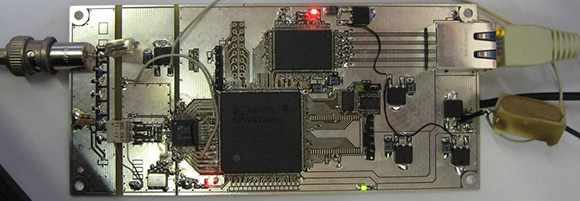
The amateur radio club at University of Twente in the Netherlands came up with something really cool: a web-based software defined radio. So what, you ask? It’s just streaming audio or something over the Internet? Nope. You can actually control this SDR over the web.
We’re deeply sorry for turning the hardware turn to slag. Really, we are.
Junk box Tesla coil

[JJ] whipped up a homemade Tesla coil out of junk he had lying around. Basically, it’s a piece of PVC pipe, a tennis ball, and aluminum foil. Even the transformer was pulled from a long-forgotten project. [JJ] is getting some really good arcs, so we’ll call this a win.
Time circuits active
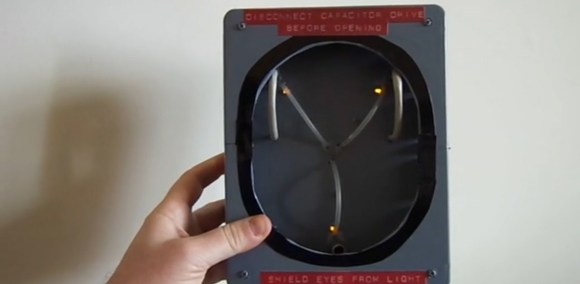
[Danilo] was invited to a costume party with a movie theme. He wanted something Back to the Future-is, so he whipped up a flux capacitor (translation). It’s based on a PIC12F675, with the microcontroller running a bit of code that flashes the LEDs just like the movie. Now on to the hoverboard project…


